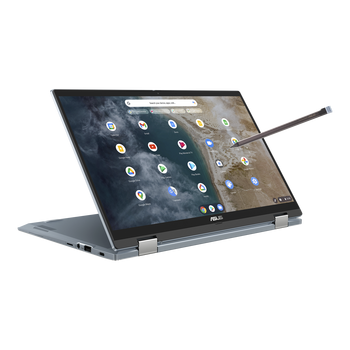- Exceptional dual-screen experience
- Powerful performance for creative tasks
- Stunning main OLED display
- Great audio quality
- Versatile 2-in-1 design
- Smooth performance
- Access to Google Play Store apps
- Durable build quality
- Heavy and bulky
- Short battery life
- Limited storage capacity
- Higher price compared to other Chromebooks
ASUS ZenBook Pro Duo 15 OLED vs ASUS Chromebook Flip CX5
When it comes to ASUS laptops, two models that stand out for their unique features and capabilities are the ASUS ZenBook Pro Duo 15 OLED and the ASUS Chromebook Flip CX5. While both devices share some similarities, they cater to different user needs and preferences. In this comparison, we'll delve into the details of each model, highlighting their strengths and weaknesses.
Design and Display
The ASUS ZenBook Pro Duo 15 OLED boasts a sleek and premium design, with a sturdy aluminum chassis that exudes elegance. Its standout feature is the dual-screen setup, which includes a 15.6-inch OLED primary display and a 14-inch secondary touchscreen display located above the keyboard. This innovative design allows for enhanced productivity and multitasking capabilities.
On the other hand, the ASUS Chromebook Flip CX5 features a more compact and convertible design, with a 360-degree hinge that enables seamless transitions between laptop, tablet, and tent modes. The device sports a 15.6-inch Full HD touchscreen display, which is perfect for web browsing, streaming, and casual gaming.
Performance
The ASUS ZenBook Pro Duo 15 OLED is powered by up to 10th Gen Intel Core i9 processors, paired with up to 64GB of RAM and NVIDIA GeForce RTX 3070 graphics. This robust configuration makes it an ideal choice for demanding tasks like video editing, 3D modeling, and gaming.
In contrast, the ASUS Chromebook Flip CX5 is equipped with up to 11th Gen Intel Core i7 processors, up to 16GB of RAM, and integrated Intel Iris Xe Graphics. While not as powerful as its ZenBook counterpart, the Chromebook Flip CX5 still delivers smooth performance for everyday tasks like web browsing, office work, and social media.
Software and Features
The ASUS ZenBook Pro Duo 15 OLED runs on Windows 10, offering a wide range of software compatibility and customization options. The device also features a comprehensive suite of productivity tools, including the ASUS ScreenPad Plus software, which enhances the dual-screen experience.
The ASUS Chromebook Flip CX5, on the other hand, operates on Google's Chrome OS, which is optimized for web-based applications and cloud storage. While it may not offer the same level of software flexibility as Windows 10, Chrome OS provides a streamlined and secure user experience, with automatic updates and built-in virus protection.
Battery Life and Connectivity
The ASUS ZenBook Pro Duo 15 OLED offers up to 10 hours of battery life, depending on usage patterns. The device features a range of connectivity options, including Wi-Fi 6, Bluetooth 5.0, USB-A, USB-C, and HDMI ports.
The ASUS Chromebook Flip CX5 provides up to 12 hours of battery life, making it an excellent choice for users who need a device that can last throughout the day. Connectivity options include Wi-Fi 6, Bluetooth 5.0, USB-A, USB-C, and a microSD card slot.
Conclusion
In conclusion, the ASUS ZenBook Pro Duo 15 OLED and the ASUS Chromebook Flip CX5 cater to different user needs and preferences. The ZenBook Pro Duo 15 OLED is a powerhouse designed for creative professionals and gamers who require top-notch performance and innovative features. On the other hand, the ASUS Chromebook Flip CX5 is an excellent option for students, casual users, and those who prioritize portability and affordability.
When choosing between these two ASUS laptops, consider your specific needs and usage patterns. If you're looking for a device that can handle demanding tasks and provide a unique dual-screen experience, the ZenBook Pro Duo 15 OLED may be the better choice. However, if you prefer a more affordable, web-centric device with a flexible design, the Chromebook Flip CX5 is an excellent alternative. Ultimately, both devices showcase the versatility and innovation of ASUS laptops, making them attractive options for users seeking reliable and feature-rich computing experiences.































